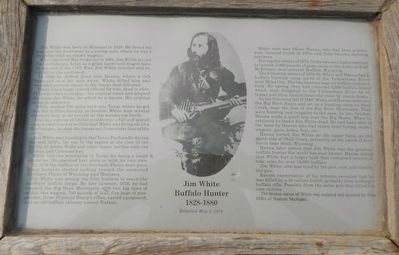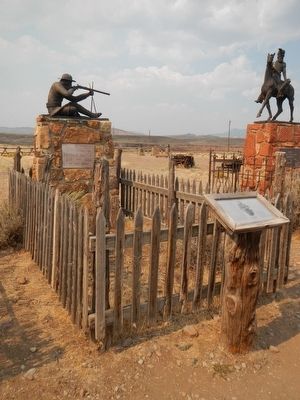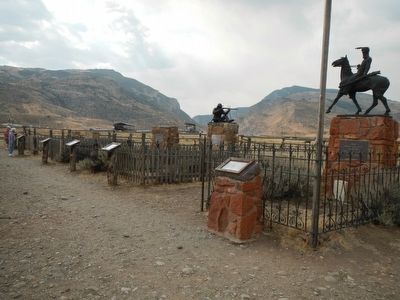Cody in Park County, Wyoming — The American West (Mountains)
Jim White
Buffalo Hunter • 1828-1880
— Reburied May 6, 1979 —
When the Civil War broke out in 1861, Jim White served the Confederate Army as a grain buyer and wagon boss. At the end of the Civil War, Jim White married and returned to the southwest.
In 1868 he drifted down into Mexico, where a rich Spaniard won his wife away. White killed him and wounded several others in the fracas that followed.
There was a large reward offered for him, dead or alive. This was when he dropped his original name and adopted the name Jim White, for which he is known. His original name is unknown.
White walked 700 miles back into Texas where he got into the buffalo hunting profession. White kept several skinners busy as he preyed on the wandering herds.
One day a group of ciboleros rode over a hill and scared away a small herd of buffalo that White was firing on. In a fit of temper, he shot the horses out from under four of the party.
Jim White was hunting in the Texas Panhandle during the mid 1870s. He was in the region at the time of the Battle of Adobe Walls and other lesser battles with the Kiowas and Commanches.
White had the reputation in Texas for being a tough character. He operated best alone or with his own men.
By 1878 the buffalo on the Southern Plains were gone. Many hunters started looking toward the unspoiled Northern Plains of Wyoming and Montana.
Jim White was among the first hunters to reach the northern buffalo range. By late summer,1878, he had reached the Big Horn Mountains with two big span of mules. two wagons, 700 pounds of lead, five kegs of gun-powder, three 16 pound Sharp’s rifles, varied equipment, and an old buffalo skinner named Watson.
White soon met Oliver Hanna, who had been a scout with General Crook in 1876, and they became hunting partners.
During the winter of 1878-79 the two men had a contract to furnish 5,000 pounds of game meat to the Army at Fort McKinney, near present Buffalo, Wyoming.
The following winter of 1879-80, White and Hanna had a buffalo hunting camp north of the Yellowstone River near Miles City. The two hunters kept six buffalo skinners busy. By spring, they had collected 4,600 buffalo hides which were freighted to the Yellowstone River by ox teams and then hauled down the river by steam boats.
In the following fall of 1880, White and Hanna came into the Big Horn Basin and set up a hunting camp on Shell Creek, near the foot of the Big Horn Mountains. They were hunting and trapping in the area. In late October, Hanna made a quick trip over the Big Horns. When he returned he found Jim White dead. He had been shot in the head by thieves who had stolen their horses, mules. wagons, guns, hides, furs, etc.
Hanna buried Jim White on the upper bank, on the north side of Shell Creek, presently on the ranch of Irvy Davis near Shell, Wyoming.
Hanna later stated that Jim White was the greatest buffalo hunter the world has ever known. Hanna stated that White had a ledger book that contained records of hide sales for over 16,000 buffalo.
Jim White, who had lived by the gun, now, also died by the gun.
Recent examination of his remains revealed that he was killed by a 50 caliber bullet; probably from a Sharp’s buffalo rifle. Possibly from the same gun that killed his own victims.
The bronze statue of White was sculpted and donated by Tom Hillis of Stanton, Michigan.
Erected by Old Trail Town.
Topics. This historical marker is listed in this topic list: Cemeteries & Burial Sites. A significant historical year for this entry is 1828.
Location. 44° 30.915′ N, 109° 6.313′ W. Marker is in Cody, Wyoming, in Park County. Marker can be reached from Demaris Drive near West Yellowstone Avenue (U.S. 14). Touch for map. Marker is at or near this postal address: 1831 Demaris Drive, Cody WY 82414, United States of America. Touch for directions.
Other nearby markers. At least 8 other markers are within walking distance of this marker. Phillip H. Vetter (here, next to this marker); John Jeremiah "Liver Eating" Johnston (here, next to this marker); Sampson E. Stilwell (here, next to this marker); W.A. Gallagher and Blind Bill (a few steps from this marker); Belle Drewry (a few steps from this marker); Trail to Old Cody City (within shouting distance of this marker); Lee Street – Cody City (within shouting distance of this marker); Stone Circles (within shouting distance of this marker). Touch for a list and map of all markers in Cody.
More about this marker. This marker is located in the cemetery at the west end of Old Trail Town.
Credits. This page was last revised on June 16, 2016. It was originally submitted on November 29, 2015, by Barry Swackhamer of Brentwood, California. This page has been viewed 1,113 times since then and 134 times this year. Photos: 1, 2, 3. submitted on November 29, 2015, by Barry Swackhamer of Brentwood, California.


